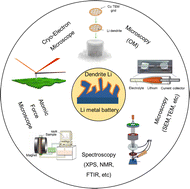The progress of in situ technology for lithium metal batteries
Abstract
Li metal anodes are considered one of the most promising anode materials because of their low potential (−0.34 V (vs. SHE)) and high energy density (3860 mA h g−1). However, safety concerns and low cycling efficiency, owing to the fragile solid electrolyte interface (SEI) and Li dendrite growth, severely limit their large-scale commercialization. The properties and structure of the SEI play a key role in the overall performance of the batteries. The mechanism of SEI formation can be preliminarily characterized by some conventional characterization methods, but SEI formation is a dynamic process, which is inevitably affected by other factors during battery disassembly, so such methods have certain limitations. Therefore, a series of advanced in situ characterization techniques have been employed to gain a clear understanding of the properties and structures of the SEI. Herein, various characterization techniques for Li metal batteries are summarized and compared, including lots of characterization tools and advanced in situ characterization techniques, and future research directions are discussed. This work is expected to serve as a foundation for the development of high-energy Li metal batteries.

- This article is part of the themed collection: 2023 Materials Chemistry Frontiers Review-type Articles


 Please wait while we load your content...
Please wait while we load your content...